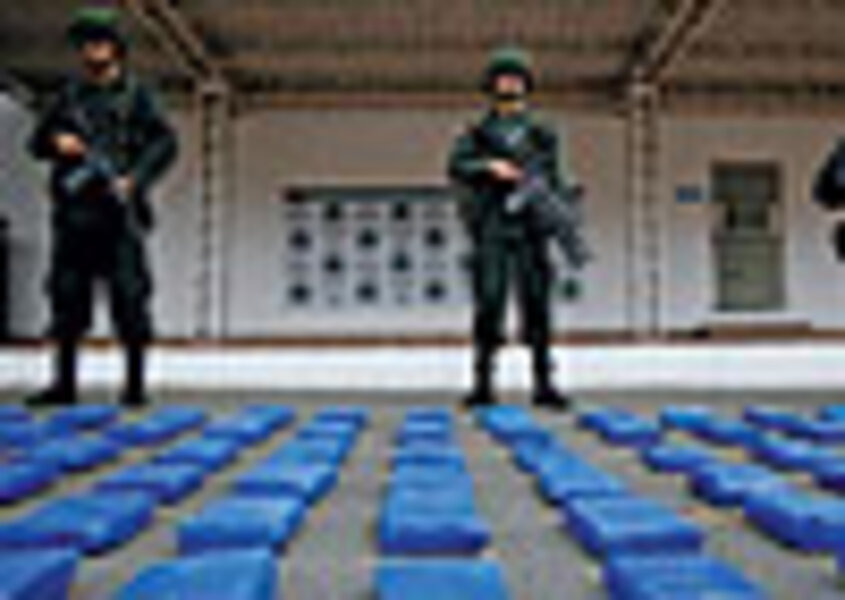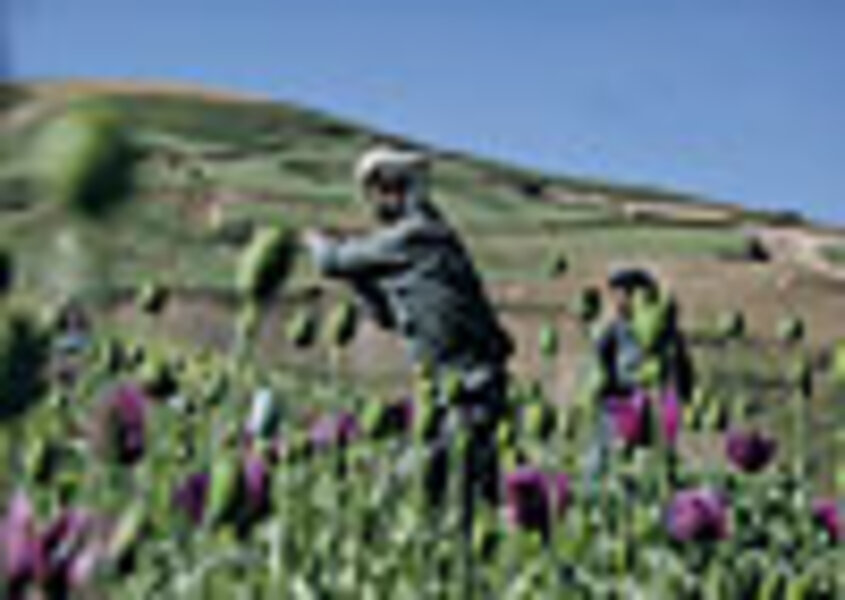US applies Colombia antidrug lessons to Afghanistan
| Mexico City; and Bogotá, Colombia
As the United States retools its counternarcotics strategy in Afghanistan, officials are looking to Colombia for lessons.
The two nations share many burdens: Colombia is the largest supplier of cocaine in the world, Afghanistan of opium. Both have impoverished rural communities easily enticed into trafficking webs. Both are vulnerable to the sway and command of insurgent groups that finance their fight with proceeds from the drug trade.
The parallels have led to calls for exporting elements of the nearly decade-old "Plan Colombia," the US-funded antinarcotics effort, to Afghanistan. Critics are wary. But it seems that, at least at the outset, the US is learning as much from its mistakes as from its successes in South America.
For example, instead of pouring money into crop eradication as it did in Colombia, the new US strategy in Afghanistan will phase out eradication, and place a new emphasis on the interdiction of opium shipments and encouraging farmers to adopt alternate crops.
The number of Drug Enforcement Agency officials in Afghanistan will increase more than sixfold by next year, to as many as 81 agents. The DEA and US military will target (to be killed or captured) the top 50 drug traffickers with ties to the Taliban.
"Even with all the mistakes in Colombia, there is also learning taking place … on how to do rural development in the context of an illicit economy," says Vanda Felbab-Brown, a fellow at the Brookings Institution in Washington and author of the book "Shooting Up: Counterinsurgency and the War on Drugs." "Depending on which pieces of Plan Colombia you pick, they might very well be applicable."
After nearly 10 years and $6 billion in US aid, Plan Colombia's focus on massive forced eradication of coca crops has only recently made a dent in the South American country's cocaine production. Colombia's efforts at offering alternative livelihoods to coca farmers suffered multiple failures over the years: With promised government subsidies never materializing and no markets for their alternative crops, many farmers went back to coca.
The "stick" of forced eradication of coca crops without a reliable "carrot," says Román Ortiz, a Bogotá-based security consultant, merely creates a "mobile social base for the insurgency" that draws on resentful farmers.
In Colombia, the insurgency is a leftist rebel army of about 10,000 soldiers known as the Revolutionary Armed Forces of Colombia (FARC), which profits heavily from the drug trade. "You can dissolve that base if you have something better to offer," he says. In other words, a "carrot."
Last year, Colombia shifted gears with an "Integrated Action" strategy – developed jointly with the US. Military, police, and civilian development agencies work together in a given area to simultaneously drive out rebel forces, destroy drug crops and processing labs, and offer alternatives to former coca farmers.
Farmers shifted to chili peppers and African palm for palm oil. The government also offers subsidies for families of those training to become forest rangers in national parks and offers vocational training in such professions as baking and car repair.
At the same time, in areas with a weak state presence, the government invested in schools, health clinics, and courts.
The strategy was applied in an area known as La Macarena last year, and the United Nations credits Colombia's 18 percent drop in coca crops in 2008 in large part to that effort.
In March in Bogotá, Adm. Mike Mullen, chairman of the US Joint Chiefs of Staff, said that elements of Plan Colombia apply to Afghanistan. "The counterinsurgency approach; the providing security for the people; the need for governance upon which the people can depend, not just national governance, but local governance; the ability to create jobs and opportunities for people who feel secure in those jobs are fundamentals that apply here and apply in Afghanistan," he said.
In Afghanistan, the area cultivated with opium poppy seed declined by 19 percent last year, compared with 2007, according to the United Nations. But the decline is modest given that Afghanistan remains the supplier of more than 90 percent of the global market for opiates. Officials estimate that the Taliban receives from $50 million to $70 million annually from the trade.
The US began training Afghan authorities for poppy eradication in 2003, but those efforts have had the same unwanted consequences as coca eradication in Colombia, including alienating farmers.
At a Group of Eight meeting in Italy in June, the US envoy to Afghanistan, Richard Holbrooke, told the Associated Press that eradication programs were driving farmers into the arms of the Taliban. "Eradication is a waste of money," he said.
The latest strategy shift comes as the Obama administration raises the stakes in Afghanistan: doubling its military presence to 68,000 troops, with an emphasis on intelligence gathering.
Detailed counternarcotics plans for Afghanistan have not been unveiled, but will include substituting wheat and other crops for poppy. There's a new emphasis on interdiction to target illegal networks that fund the insurgency. "We need to keep that effort up," says DEA spokesman Rusty Payne, "to target large-scale drug traffickers providing material support to folks like the Taliban."
Ms. Felbab-Brown says that interdiction is crucial, not because it bankrupts insurgents but because it can reduce the political power of criminal actors, whether they are linked to the government or the Taliban.
She warns that while interdiction in Colombia reduced the influence of the Medellín and Cali cartels, it created a vacuum allowing the FARC to grab greater control of the drug trade. In Afghanistan, if the US goes "after too many of the big traffickers at the same time," she says, "it gives an impetus for the Taliban to take over their position."
To date, Colombia's experience has just started to be shared with Afghan officials. Last year, the US State Department sponsored a small group of Afghan police to go to Colombia to train with a special antinarcotics Colombian force.
Josh Walsh, senior associate for drug policy at the Washington Office on Latin America, a human rights organization, says that Colombia is rife with lessons, both good and bad. One of the upsides of Plan Colombia, he says, has been a more capable security force, but even then, authorities must be vigilant about human rights abuses.
But Bruce Bagley, a drug expert at the University of Miami, says that exporting elements of Plan Colombia to Afghanistan is premature. "In Afghanistan, nation- and state-building has not been achieved yet, so lessons from Colombia are basically irrelevant," he says. Colombia had a well-established government, army, and economy when Plan Colombia was launched in 2000.
"The Colombian experience can be useful for Afghanistan, but the road to success will be much longer," says Mr. Ortiz.
Ricardo Vargas, a Colombian drug policy expert, says that Colombia's FARC rebels never fully capitalized on the anger of farmers over forced eradication of drug crops. The Taliban, on the other hand, "are much more capable of doing that, offering lines of credit and social programs that challenge the legitimacy of the state."•






